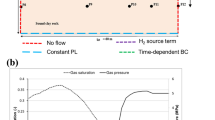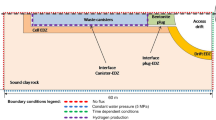Abstract
In low/intermediate-level waste (L/ILW) repositories, anaerobic corrosion of metals and degradation of organic materials produce mainly hydrogen, methane, and carbon dioxide. The Swiss reference concept for the L/ILW repository consists of parallel caverns sealed off from a single access tunnel in a deep low-permeability claystone formation. The potential buildup of excess gas pressures in the backfilled emplacement caverns was investigated in a series of two-phase flow models. In the first step, a large-scale model was constructed, implementing the 3D radial tunnel and cavern geometry with a simplified rectangular geometry. In the second step, the potential impact of the detailed geometry of the engineered barrier system (EBS) and the associated heterogeneity inside the cavern was examined using detailed models of the repository caverns, tunnel seals, access tunnel, and surrounding host rock. The simulation results from the large-scale 3D repository model show that during the early post-closure period simulated pressures can vary significantly between different parts of the repository. The simulated pressure increase in the emplacement caverns remained below the fracture pressure of the rock for realistic assumptions. Gas flow is largely limited to the EBS and the excavation disturbed zone (EDZ); thus, gas flows through and around the repository seal into the adjacent tunnel system, which is also demonstrated in the detailed repository-cavern model. The repository seal model described the detailed two-phase flow pattern of early time resaturation of the repository by water inflow from the ramp and subsequent counter flow associated with the gas flow from the repository cavern. Overall, the results of the detailed models complement and confirmed the results of the large-scale 3D model in terms of the timing of the pressure peaks and the migration of gas from the cavern into the surrounding host rock and through the repository seal.
Similar content being viewed by others
References
Calder N., Avis J.: mView User Manual, Version 4.0, 2006. Intera Engineering, Ottawa (2006)
Calder, N., Avis, J., Humphreys, P., King, F., Suckling, P., Walsh, R.: Postclosure safety assessment (V1): Gas modeling: Report NWMO DGR-TR-2009-07, Toronto, Ontario, Canada (2009)
Croise, J., Mayer, G., Talandier, J., Wendling, J.: Modeling the hydrogen generation and migration from and emplacement drift with intermediate-level radioactive waste: impact of water consumption and water-dependent corrosion rate. In: Proceedings TOUGH Symposium 2009, Lawrence Berkeley National Laboratory, California (2009)
Cuss, R.J., Harrington, J.F., Noy, D.J., Wikman, A., Sellin, P.: Large scale gas injection test (LASGIT): Results from two gas injection tests: concerence on ‘Clays in Natural & Engineered Barriers for Radioactive Waste Confinement’, Nantes, March 29–April 1 (2010)
Mualem Y.: A new model for predicting the hydraulic conductivity of unsaturated porous media. Water Resour. Res. 126, 513–522 (1976)
NAGRA: Effects of post-disposal gas generation in a repository for low- and intermediate-level waste sited in the Opalinus Clay of Northern Switzerland. Nagra Technical Report NTB 08-07. Nagra, Wettingen, Switzerland (2008)
Perko, J., Weetjens, E., Yu, L.: Thermo-hydraulic analysis in case of gas generation in a disposal facility for vitrified high-level radioactive waste in Boom Clay. In: Proceedings TOUGH Symposium 2009, Lawrence Berkeley National Laboratory, California (2009)
Poller, A., Enssle, C.P., Mayer, G., Croisé, J., Wendling, J.: Repository-scale modeling of the long-term hydraulic perturbation induced by gas and heat generation in a geological repository for high and intermediate level radioactive waste - methodology and Results. In: Proceedings of TOUGH Symposium 2009, Berkeley, California (2009)
Pruess, K., Oldenburg, C., Moridis, G.: TOUGH2 user’s guide, Version 2.0, LBNL Report, LBNL-43134, Berkeley, CA (1999)
Senger R.K., Ewing J.E.: Gas-L/ILW: Gas Pressure buildup and transport in a deep geologic L/ILW repository in Opalinus Clay. Nagra, Wettingen (2008)
Swift, B., Hoch, A., Jackson, P., James, M., Bate, F.: Modeling multiphase flows form a repository in different geological environments. In: Proceedings TOUGH Symposium 2009, Lawrence Berkeley National Laboratory, California (2009)
Van Genuchten, M.Th.: A closed-form equation for predicting the hydraulic conductivity of unsaturated soils. Soil Sci. Soc. Am. J. vol. 44 (1980)
Zhang, K., Wu, Y-S, Pruess, K.: User’s Guide for TOUGH2-MP - A massively parallel version of the TOUGH2 Code, Lawrence Berkeley National Laboratory, California Paper LBNL-315E (2008)
Author information
Authors and Affiliations
Corresponding author
Rights and permissions
About this article
Cite this article
Senger, R., Ewing, J., Zhang, K. et al. Modeling Approaches for Investigating Gas Migration from a Deep Low/Intermediate Level Waste Repository (Switzerland). Transp Porous Med 90, 113–133 (2011). https://doi.org/10.1007/s11242-010-9709-2
Received:
Accepted:
Published:
Issue Date:
DOI: https://doi.org/10.1007/s11242-010-9709-2




